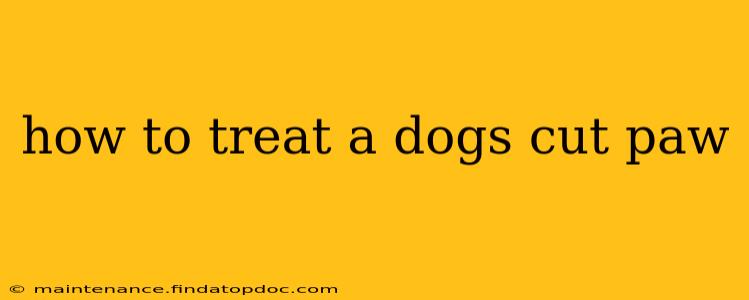A cut paw can be a distressing experience for both you and your canine companion. Knowing how to properly treat a dog's injured paw is crucial for preventing infection and ensuring a swift recovery. This guide provides a step-by-step approach, addressing common concerns and offering expert advice.
Is it a Minor or Major Cut?
Before diving into treatment, it's essential to assess the severity of the injury. Minor cuts may only require basic first aid, while major wounds need immediate veterinary attention.
Minor Cuts: These are typically superficial, involving only the outer layers of skin. There's minimal bleeding, and your dog doesn't seem overly distressed.
Major Cuts: These are deeper wounds, possibly involving muscle or bone. There's significant bleeding, your dog is whimpering or limping severely, and the paw may appear deformed or swollen. Seek immediate veterinary care for major cuts.
How to Treat Minor Cuts on a Dog's Paw
For minor cuts, follow these steps:
-
Clean the Area: Gently wash the paw with lukewarm water and a mild, antiseptic soap (avoid harsh chemicals). You can use a clean washcloth or cotton pad. Thoroughly remove any dirt, debris, or foreign objects.
-
Control Bleeding: If there's minor bleeding, apply gentle pressure with a clean cloth or gauze for a few minutes. Elevating the paw slightly can also help.
-
Apply Antibiotic Ointment: Once the bleeding stops and the paw is clean, apply a thin layer of antibiotic ointment (specifically formulated for animals; always check with your veterinarian). This helps prevent infection. Avoid using human-specific ointments.
-
Bandage (Optional): A bandage may be helpful if your dog is constantly licking the wound, which can interfere with healing and introduce bacteria. Use a clean, soft bandage that allows for some air circulation. Ensure the bandage isn't too tight, restricting blood flow.
-
Monitor for Infection: Watch for signs of infection, such as increased swelling, redness, pus, or a foul odor. If you notice any of these, contact your veterinarian immediately.
How to Treat a Dog's Paw After a Walk
Regular walks are essential, but they can also expose your dog's paws to various hazards. Here's how to care for your dog's paws after a walk:
- Check for Injuries: After each walk, carefully inspect your dog's paws for any cuts, scrapes, thorns, or foreign objects embedded in the pads.
- Clean and Dry: Wipe your dog's paws with a damp cloth to remove dirt, debris, and salt from the roads. Ensure they are thoroughly dried to prevent moisture buildup.
- Paw Balm (Optional): Consider using a dog-specific paw balm to moisturize and protect the pads, especially during harsh weather conditions.
What If My Dog Is Licking His Paw Excessively?
Excessive licking can hinder healing and introduce infection. To prevent this:
- Distraction: Keep your dog occupied with toys or chews to divert their attention from the paw.
- E-Collar (Elizabethan Collar): An e-collar (cone) can prevent your dog from reaching and licking the wound.
- Bitter Apple Spray: Applying a pet-safe bitter apple spray to the paw can deter licking. However, consult your vet before use.
What are the signs of infection in a dog's paw?
Signs of infection include:
- Increased swelling: The paw becomes significantly more swollen than initially.
- Redness and heat: The area around the cut becomes red and feels warmer than the surrounding tissue.
- Pus: A yellowish or greenish discharge appears from the wound.
- Foul odor: The paw emits a bad smell.
- Limping or reluctance to put weight on the paw: Your dog avoids using the injured paw.
- Fever: Your dog might have a fever (check with a thermometer).
If you notice any of these signs, contact your veterinarian immediately.
When Should I Take My Dog to the Vet?
It’s crucial to seek veterinary attention if:
- The cut is deep or severe.
- Bleeding is profuse or doesn't stop after applying pressure.
- There are signs of infection.
- Your dog is exhibiting signs of pain or discomfort.
- You're unsure about the best course of action.
Remember, this information is for general guidance only. Always consult with your veterinarian for diagnosis and treatment of your dog's injuries. They can provide personalized advice based on your dog's specific needs and the severity of the wound. Early intervention is key to ensuring a successful recovery.
